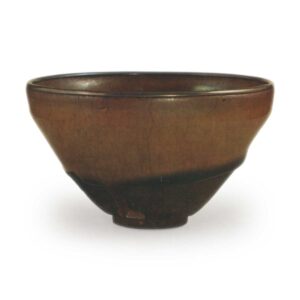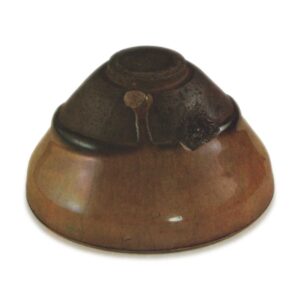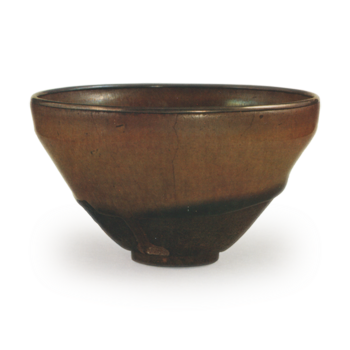

Tokugawa Art Museum
Height: 6.3-6.4cm
Diameter: 10.7cm
Foot diameter: 3.4cm
Height: 0.5cm
Height: 6.3-6.4cm
Judging from the shape and the way the glaze has been applied, it looks like a Kenkan ware, but it is actually not from the Ken kilns. The clay, which appears dark in the illustration, is not originally black like that of the Kenkan, but has become dark over the years due to wear and tear. If you look closely, you can see that it is a fine porcelain clay, and it is thought that it originally had a grayish-white color. The way the foot ring and the area around the foot ring have been scraped is exactly the same as that of the Kenkan, and it is easy to mistake it for a Kenkan. It is probably from a kiln in Zhejiang or Fujian province that made tenmoku in the same way as kenkan. It may sound like a rustic piece, but this tea bowl is a gem, with a small size but a sharp finish.
By the way, what makes this tea bowl so different from others is the color and tone of the glaze. As the name “yellow tenmoku” suggests, the glaze is a yellowish color all over. It is a thick, highly transparent, glassy glaze, and you could think of it as a light-colored candy glaze. In the case of ordinary tenmoku, the iron in the underglaze melts into the glaze, darkening the glaze and causing the appearance of rabbit-hair streaks and oil spots on the glaze surface, but this is not the case here. However, if you look closely, you can see that there are very light-colored rabbit-hair streaks running across the surface. They are just hidden by the color of the glaze.
From this point of view, it can be said that the amount of iron in the underglaze is quite low in this tea bowl, and that is why the glaze is so light. Only the part of the glaze pool on the outside of the bowl is a dark color close to black due to the thick glaze layer, but in normal Tenmoku, the entire glaze is this color. Anyway, perhaps because the glaze is this light in color, the cracks on the inside of the bowl stand out well. The cracks are quite rough due to the thick glaze, but they become somewhat finer towards the bottom. Even in the Tenmoku ware from the Kenmoku kiln, there are cracks, but because the glaze is dark, they are often not noticed.
As you can see from the above, the glaze of this Tenmoku ware is not particularly beautiful, and it is not something that would be particularly highly prized. The reason why this tea bowl has been highly praised since ancient times is that it has a film on the glaze surface that gives off a very beautiful iridescent sheen. There have been several tea bowls with beautiful red overglaze enamels, but in the case of this tea bowl, the beauty of the glaze is even more pronounced because the glaze color is a light yellow.
There is a glaze blister on part of the glaze on the outside, which has been repaired with lacquer. The rim is silver. This tea bowl was originally in the collection of Tokugawa Ieyasu, and was given to the Lord of Bishu in 1618, and is one of the so-called Suruga gifts.



